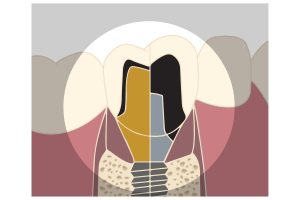
An abutment is a crucial component used in dental implant restorations.
An engineering term, the word “abutment” describes something designed to hold something else (such as a bridge support). In the context of dentistry, an abutment serves as a connector between the implant and the restoration (for example, an artificial tooth, crown or dentures).
After an implant has been surgically placed into the bone and osseointegration has successfully occurred, the abutment acts as a support mechanism between the implant and the restoration.
Custom-made abutments are made by a dental laboratory, such as Watersedge. Highly skilled dental technicians like ours fabricate each abutment to precisely fit the implant and match the patient’s natural teeth in terms of shape, size, and colour using impression scans and instructions provided by the dentist. Pre-fabricated stock abutments are also an option, but they have limitations and may not offer optimal performance.
[Contact Us for Custom Abutments]
[Read Our FAQs About Custom Abutments]
Steps to Request Abutments from Watersedge Dental Lab
To facilitate an abutment request, Watersedge Lab requires the following from our dental partners:
- Upper and lower implant level impressions.
- Open tray, closed tray or digital impressions
- Bite registration.
- Shade selection for the final restoration.
- Desired material for the final crown or restoration.
- Prescription (indicating the return date).
If you are unsure about specific requirements, simply add “Call me” to the prescription, and our Ottawa-based staff will contact you to discuss the available options and assist in making an optimal decision for your patient.
Watersedge Dental Laboratory accepts digital files, including results of scan data from intraoral scanners and scan bodies. Many dental surgeons now incorporate this step and send scans directly to our laboratory, enabling us to create the custom abutment and crown without the dentist needing to see the patient until the final restoration appointment. We embrace this streamlined process as it provides our partners with a convenient and efficient experience.
Stock Abutments vs. Custom Abutments
There are two main options to consider: stock abutments and custom abutments. Understanding the differences between them will help you make informed decisions regarding your dental restoration cases.
Stock Abutments:
A stock abutment is a premade option that is mass-produced in standard sizes and shapes. These stock implant abutments are readily available and designed to fit the average patient’s mouth, following a “one-size-fits-all” approach. Manufacturers have aimed to strike a balance that works for most people, but they are not an optimal fit for everyone, especially individuals with unique requirements.
Custom Abutments:
A custom abutment is a personalized and tailored solution designed and crafted by a dental lab. Through advanced computer-aided design and manufacturing techniques, technicians at dental labs like Watersedge meticulously create custom abutments based on the patient’s dental impressions and specific instructions. This ensures a precise fit and seamless integration with the patient’s natural teeth. The result is an abutment that not only functions optimally but also enhances the aesthetic appeal of the final restoration. Custom abutments can also help mitigate potential complications associated with bruxism, enhancing the longevity and success of dental implant restorations.
A common misconception surrounding custom abutments is the belief that they are cost-prohibitive. In the past, the labour-intensive process and manual craftsmanship associated with custom abutments made them more expensive. However, with advancements in technology and automation, the cost differential has diminished significantly. Today, their performance and aesthetic benefits far outweigh any minimal additional expense. Investing in a custom abutment leads to superior outcomes, ultimately saving both time and money in the long run.

Same-on-Same vs Aftermarket Components
Watersedge is primarily a same-on-same laboratory, meaning that we prioritize utilizing components manufactured by the same company— an original equipment manufacturer or OEM—whenever possible. Studies consistently show that this approach ensures the highest level of compatibility, precision, and bacterial resistance as opposed to using aftermarket options.
Aftermarket components, which are approved by Health Canada, are not produced by the original implant manufacturers and, in many cases, do not offer the same performance. In addition, using aftermarket components can void the warranty provided by an implant manufacturer, leading to additional costs for clinicians and patients.
It is important to note that there are unique cases where aftermarket options may be the best choice. In such situations, Watersedge engages in open communication with our dental partners and discusses the considerations of using aftermarket components.
[Contact Us for Custom Abutments]
Why Ask Watersedge Dental Lab for a Custom Abutment?
1. Enhancement of Soft Tissue Draping
Custom abutments are often preferred over stock abutments because soft tissue doesn’t respond well to disturbance, particularly when bacteria are introduced during the connection process. If and when bacteria enter the small gap between the implant and the connected component, tissue may recede, leading to challenges in soft tissue management and an inability to achieve optimal aesthetic results.
We know that your patients not only want a functional tooth but also desire a natural appearance; thus, managing soft tissue around dental implants is paramount. At Watersedge, efforts are made to shape and manage the contour of the tissue and prevent issues like black triangles (aka “pepper spots”) or gaps between teeth caused by inadequate soft tissue.
Proper management and shaping of the gingival surface are essential to ensure optimal esthetics and harmonious integration with the surrounding soft tissues; therefore, temporary crowns and healing abutments that apply varying levels of pressure are often used to gradually shape the tissue and create the desired soft tissue drape in an esthetic zone. However, in situations where soft tissue contouring is less critical, such as cases involving posterior teeth, the focus may shift directly from the healing abutment to the final restoration without involving temporaries.
2. Maximization of Titanium Optimizes Strength
When designing a custom abutment, the titanium can be as wide or thick as necessary, significantly increasing the strength of the implant restoration and reducing the risk of failure. In contrast, stock abutments are pre-determined in shape and size and limit the ability to modify the dimensions of the titanium structure.
3. Replication of Natural Tooth Shape
Custom abutments are also precisely contoured to mimic the natural root shape of a tooth, allowing for early manipulation of soft tissue contouring. Factory-made titanium abutments (also known as titanium bases or TiBases) are typically round in shape. As a result, restorations often flare from the round surface, resulting in a “mushroom crown” appearance. Custom abutments, on the other hand, begin with a contour that resembles the final crown, preserving natural soft tissue and creating a natural emergence profile.
4. Increased Surface Area for Cementation
The bond between an abutment and a restoration, such as a crown, relies on a layer of cement, which is prone to fracture or de-cementation. When using a custom abutment that is contoured to be more ovate or rectangular, the surface area for the cement layer can be dramatically increased. This ensures greater stability for the crown in the patient’s mouth and minimizes the possibility of a crown detaching from the abutment after delivery to the patient.
5. Minimization of Rotational Movement
Custom abutments help minimize rotation by incorporating grooves or flat aspects into the connection. These anti-rotational features reduce the forces exerted on the restoration and minimize the risk of cement fracture. When using a circular stock abutment without modifications, there is a greater chance of rotational movement.
6. Precise Margin Control and Gap Positioning
With custom abutments, the position of the gap and margin height can be controlled, ensuring that margins in aesthetic areas are positioned beneath the tissue line for a pleasing appearance. Stock abutments offer limited control over the placement of margins.
Why Work with Watersedge Dental Laboratory for Custom Abutments?
Advanced Technology and Milling Capabilities
At Watersedge Dental Lab in Ottawa, we take pride in our advanced in-house technology, as it sets us apart from other local labs. Our ability to create custom abutments using computer-aided design (CAD) and computer-aided manufacturing (CAM) technologies provide exponential benefits to our dental partners.
In the CAD phase, we utilize digital scans to design the precise shape of an abutment that will provide positive, predictable results and offer ideal tissue support. This design is then transferred to our CAM process. There, milling machines employ subtractive technology to carve out the desired abutment from a block of titanium, also known as a “titanium blank,” which we source directly from implant manufacturers. These same-on same titanium blocks have pre-manufactured connections to the implant, ensuring compatibility and accuracy.
Once milling is complete, the abutment undergoes mechanical polishing and is passed on to our skilled technicians for further refining. It is the CAD/CAM technology that ensures the functional aspects of the abutments and the craftsmanship of our technicians that adds the final touch of beauty to the finished product.
Many labs lack in-house titanium milling capabilities and, instead, accomplish this step through partnerships with implant companies or external milling centers. With our in-house capabilities, Watersedge achieves significant time and cost savings. As a result, we are able to provide affordable and streamlined dental solutions and pass on savings to you and your patients.
Expertise and Skill:
Our skilled designers excel at their work and make every effort to eliminate the need for adjustments once the design becomes a reality. They are all well-trained in virtual reality design and possess the expertise needed to maximize the benefits of custom abutments. Using a reverse-engineering approach, they shape each abutment in such a way that perfectly complements the final restoration, optimizing its functionality.
Customization and Anodization Capabilities
At Watersedge Dental Lab, we offer in-house anodization, a process that allows us to change the natural silver colour of the titanium to a warm gold colour that prevents tissue tattooing. (Silver-colored abutments can give a blue appearance under translucent soft tissues.) This process of anodization guarantees the best possible aesthetics for your patients.
Quick Turnaround
Typically, the turnaround time for implant cases is around ten days. However, we strive to expedite the process, particularly for single crowns on implants, which we are often able to complete quicker. We understand the importance of meeting tight deadlines and always strive to assist dental partners in urgent need of our services.
Enhanced Collaboration
At Watersedge, we are pleased to share design screenshots with—and gather feedback from—dental practitioners that wish to collaborate. Incorporating this input leads to enhanced satisfaction and predictable outcomes.
Custom Abutment FAQs
My patient has deep implants and tall crowns. Can I use a stock abutment?
In cases of deep implants with tall crowns, the lever effect becomes more significant and increases the risk of crown dislodgement. Thus, the ability to maximize abutment height with a custom abutment is necessary to prevent this issue.
Does Watersedge Dental Lab provide chairside care?
At Watersedge Dental Lab, we offer chairside services when requested. An example would be “all-in-a-day” cases. Because these cases involve the placement of implants and the immediate fitting of full digital dentures on the same day, our technicians work closely with surgeons and restorative dentists to ensure a seamless process.
Can Zirconia be used for a custom abutment?
Yes, zirconia can be used. While Watersedge prioritizes using titanium connections with implants to ensure optimal compatibility, we also utilize white-coloured zirconia in combination with a titanium base to create custom abutments. However, these zirconia abutments require an additional layer of cement, and it is important to acknowledge that this introduces an additional point of failure.
What is the difference between implant-supported and implant-retained restorations?
Implant-supported restorations, for example, an abutment with a crown, are fixed and remain in the mouth. In contrast, implant-retained restorations, such as dentures with stud attachments, can be removed while still being secured by implant abutments. Watersedge Dental Lab specializes in both implant systems.